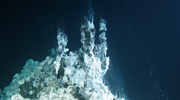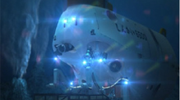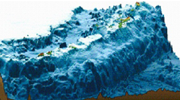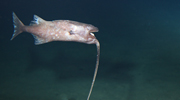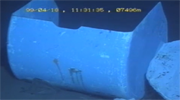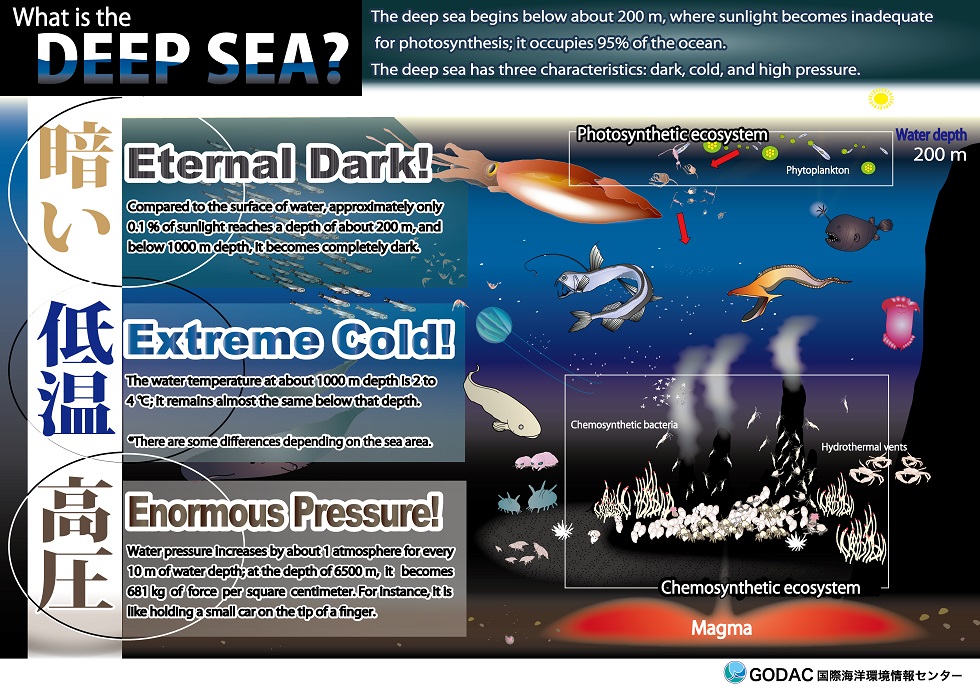
What is the deep sea like?
The deep sea is a harsh environment featuring "high pressure", "low temperature" and "complete darkness".

Water pressure increases by about 1 atmosphere for every 10m of water depth; at the depth of 6500m, it becomes 681kg of force per square centimeter.
For instance, it is like holding a small car on the tip of a finger.
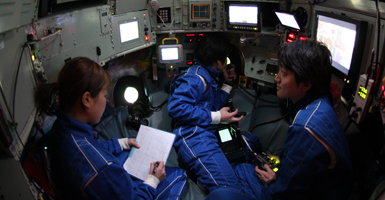
The water temperature at about 1000 m depth is 2 to 4℃; it remains almost the same below that depth.
*There are some differences depending on the sea area.
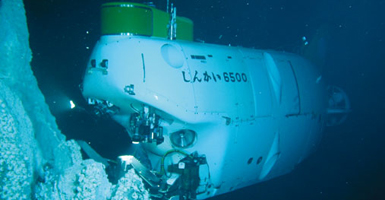
Compared to the surface of water, approximately only 0.1% of sunlight reaches a depth of about 200m, and below 1000m depth, it becomes completely dark.
How to explore and research the deep sea
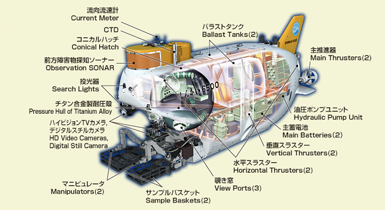
While underwater robots which are unmanned, remotely operated vehicles equipped with a video camera and mechanical arms (known as manipulators) have generally been used for deep-sea surveys, manned deep-sea research vehicles have also been important in allowing direct observation around the world.
JAMSTEC has the Shinkai 6500, which has a world class diving capability (max depth of 6,500 m). As well as exploring the deep ocean around Japan, the Shinkai 6500 has conducted research surveys all over the world such as the Indian Ocean, South Atlantic Ocean and Caribbean Sea.

As radio waves don't work properly under the sea, "sound waves" are used instead.
Under the sea, sound travels farther than on the ground.
Marine mammals such as whales use sound to communicate over thousands of kilometers.
Likewise, sound waves are practical in deep sea exploration to investigate the seafloor topography and for voice and video communication.
Seafloor topography
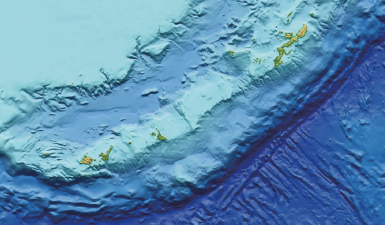
The seafloor has mountains and valleys in the same way as the land does.
You can see steep cliffs, fissures, and complex shapes of solidified lava as well.
And it is also a feature of the deep sea that much bigger trenches and ridges (mountain ranges) can be seen than on land.
In 1977, a "hydrothermal vent" spouting hot water of 200℃ to 400℃ from the seabed was observed for the first time by a submersible research vessel of the United States.
The sediments produced from some of the components in the hot water creates chimney-like hydrothermal vent.
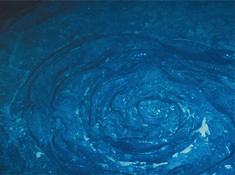
Lava Solidified as it Cooled Creating a Whirlpool Form
(North Fiji Basin, 2,707m Depth)
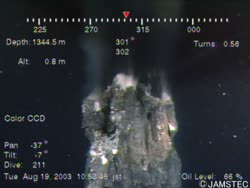
Active Chimney
(Nansei Islands Izena Hole, 1,344m Depth)
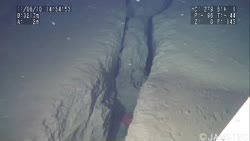
Open Cracks after the Great East Japan Earthquake
(Off Sanriku, 3,216m Depth)
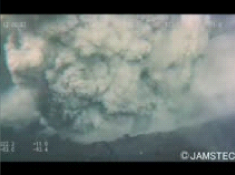
Submarine Volcano
(Mariana Arc, 530m Depth)
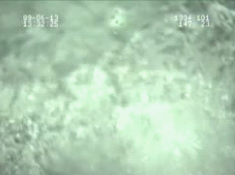
Bubble
(Nansei Islands Izena Hole, 1,333m Depth)
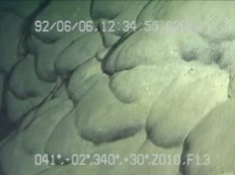
Pavement-type Manganese crust
(Nansei Islands Ryukyu Trench, 6,200m Depth)
Deep sea life
It has been said that there are not many organisms in the deep sea due to lack of food.
However, in fact, a huge range of organisms have been identified, and it is also believed that many undiscovered organisms remain to be found.
Some of the deep sea creatures as typified by Macrouridae and Chimaeridae move slowly so they consume as little energy as possible because they have less food. Tripod Fish, which stand on the seafloor with three long fins, keep standing without swimming most of the time.
On the other hand, some organisms move actively for the same reason. Sea cucumbers, which are often observed in shallow waters such as coral reefs, tend to be perceived as sedentary. But in the deep sea, they swim and jump seeking food.
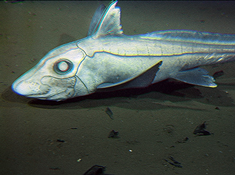
Chimaeridae gracefully flapping its wing-like breast fins
(Nansei Islands, Hatoma Knoll, 1,529m Depth)
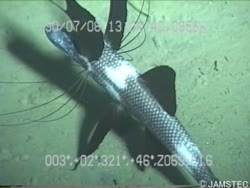
Bathypterois guentheri standing on the seabed on its three long fins
(Sruga Bay, 906m Depth)
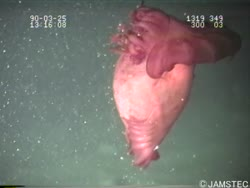
Dream-like swimming of Enypniastes eximia
(Suruga Bay off Fujikawa, 1,320m Depth)
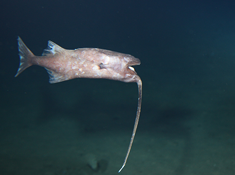
Gigantactinidae sp. displaying the long lure on its head (known as an illicium)
(North Pacific Ocean, 5,370m Depth)
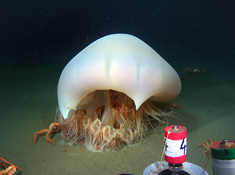
Huge Jellyfish Sunk to the Bottom of the Deep Sea
(Japan Sea Oki Bank, 930m Depth)
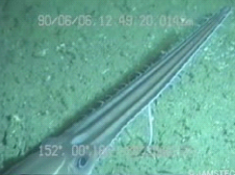
Sharp saw-like teeth projecting from the long snout of Pristiophorus japonicus
(South Hatsushima, Sagami Bay, 1,529m Depth)
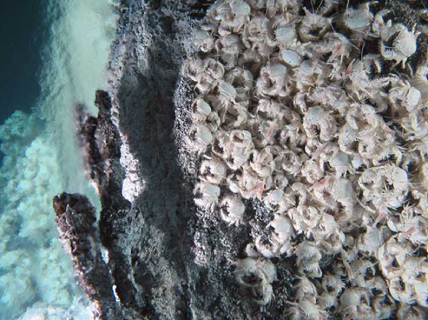
Most life on Earth depends on light from the sun for energy. But in the deep sea, where sunlight never reaches, some forms of life exist that are not dependent on solar energy.
They depend instead on "chemosynthetic bacteria" which can get their energy from the hydrogen sulfide and/or methane gasses dissolved in hot water venting from deep in the earth, instead of using solar energy.
This kind of ecosystem is called a "Chemosynthetic ecosystem".
"Chemosynthetic communities" make up this ecosystem, and they can be classified into three community groups based around: hydrothermal vents, hydrocarbon seeps, and whale falls (whale carcasses that sink down to the ocean floor).
Hydrothermal vents can possibly be the place where the earliest form of life on earth developed. The study of hydrothermal vent communities can not only reveal the evolution of early life, but can also be a clue to explore the possibility of extraterrestrial life.
Deep-sea marine debris
The deep sea, as one part of "the sea", is connected to the shallow sea.
People are concerned about the impact that human-produced marine debris has on the deep-sea environment, but opportunities to observe the deep sea are limited compared to the shallow sea, where we can easily see debris drifting in the sea or to the shore. That means that much of what happens in the deep sea is unknown.
Under such circumstances, it is fair to say that the records of "deep-sea debris" in the videos taken by JAMSTEC during its deep-sea survey are very valuable.
These records show deep-sea life making their habitat around this debris, and so reveal some of the effects of deep-sea debris on the environment.
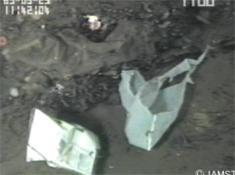
Plastic bags drifting in the deep sea
(Sagami Bay, 1,100m Depth)
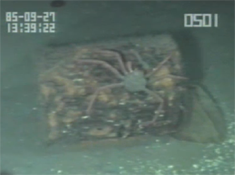
King crab clinging onto deep-sea debris
(Suruga Bay, 500m Depth)
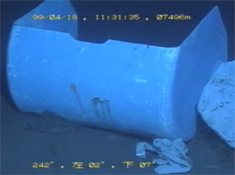
Human-produced debris found at a depth of over 7,000m
(Japan Trench, 7,496m Depth)


